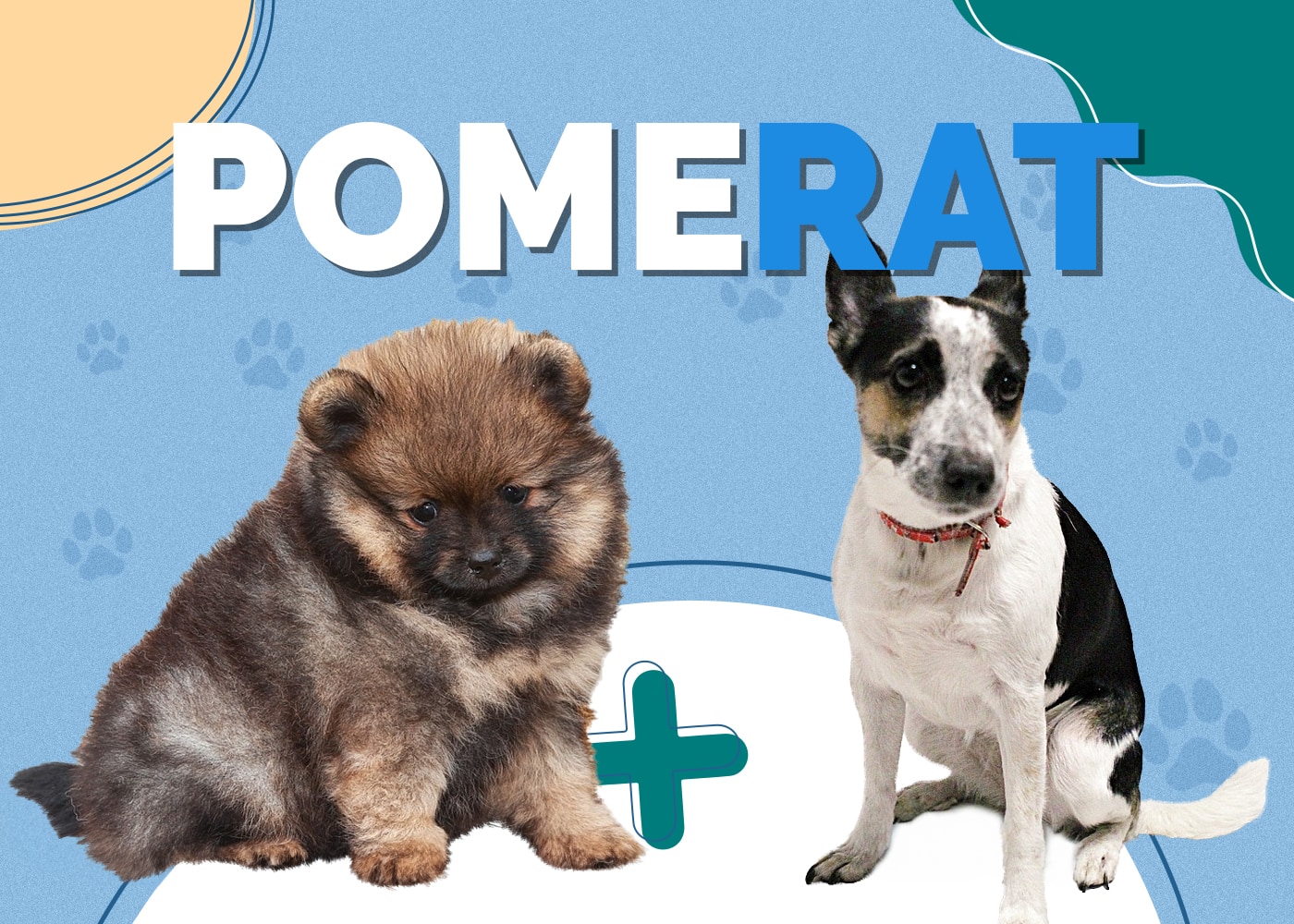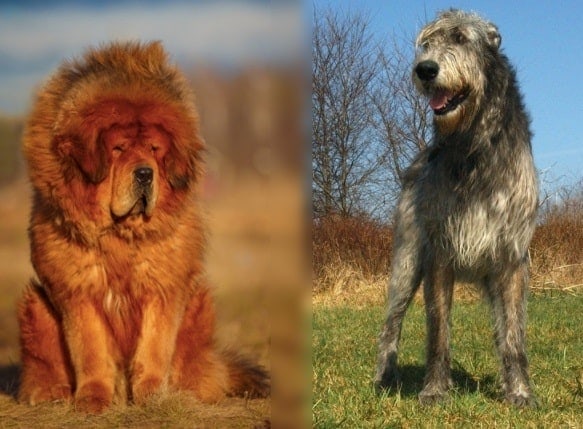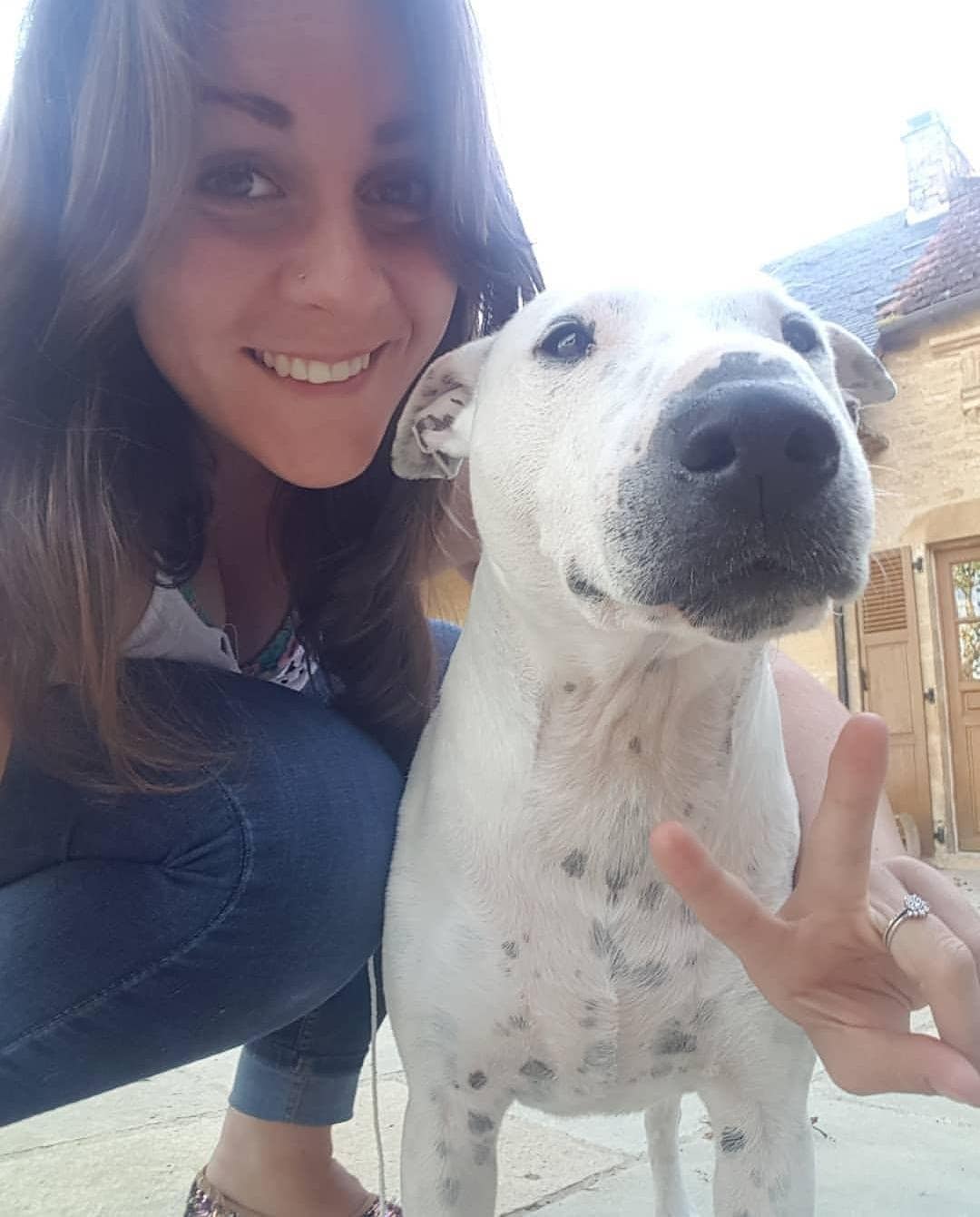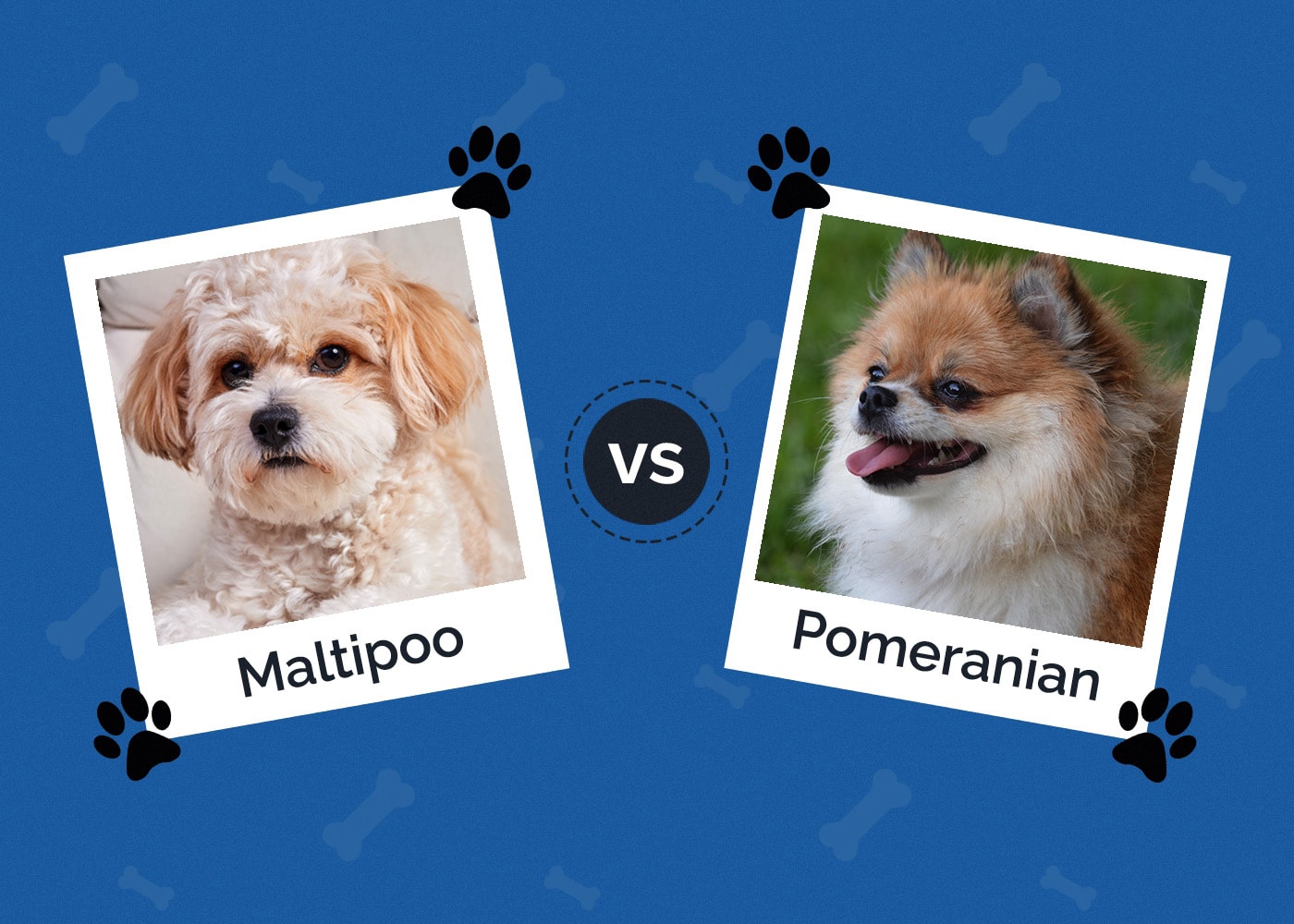Pomerat (Pomeranian & Rat Terrier Mix) Info, Pictures, Traits & Facts

Updated on

Height:
8–13 inches
Weight:
5–17 pounds
Lifespan:
12–18 years
Colors:
Black, white, grey, brown, tan, orange, blue, chocolate, pearl, lemon and apricot, bi-color or tri-color
Suitable for:
Active individuals or families, small dog lovers, those seeking a dog adaptable to smaller living situations
Temperament:
Active, Playful, Inquisitive, Extroverted, Friendly, Affectionate, Intelligent, Sociable, Alert
Are you looking for a tiny dog with a heart of gold? Then take a peek at the perky, sweet Pomerat! Pomerats are lively enough for active owners and affectionate enough for lap dog lovers. Their playful and inquisitive nature makes them great playmates for older children.
Though a new and relatively rare hybrid, we can look into the history of the two parent breeds to know a little more about this Pomeranian Rat Terrier mix. Pomeranians are named for their region of origin in Poland, Germany, and Pomerania. They are a toy breed that descends from the German Spitz, and in Germany are commonly called Zwergspitz or “Dwarf-Spitz.”
These little dogs have been known in Europe since the 1700s when they became a favorite breed of multiple members of English royalty like Queen Victoria. The breed has decreased in size by nearly half since Victorian times and is still kept as a companion dog today.
Though only a recent addition to the American Kennel Club registry, the American Rat Terrier and dogs like it have been used as pest control and companions for many years. They were prevalent on farms in the 1920s and 30s but have lost popularity and become a relatively rare breed.
Pomerat Puppies
Pomerat puppies are some of the cutest, most heart-melting creatures you’ve ever laid eyes on. Their small size and fun-loving attitude have won over many breeders and buyers. Before searching for a puppy, it’s best to ensure you can care for a Pomerat for several years.
Are you financially and emotionally stable enough to care for a dog for as many as 17 years? Does your work schedule keep you away from home all day? Will it just be you bearing the responsibility for a new pup, or will you have help?
If you go to a breeder, don’t be afraid to ask some questions of them as well. They will be able to give you an idea of the health costs, food costs, and how much training and socialization a Pomerat may need.
3 Little-Known Facts About the Pomerat
1. The Name “Pomeranian” Refers to More Than Just the Dogs.
In fact, many creatures from the region of Pomerania share a similar moniker!
Pomeranian Coarsewool sheep have been cultivated in the area for over 3,000 years. Pomeranian ducks or Pemmern ducks and Pomeranian geese are also found in this same area of Central Europe.
2. Rat Terriers Used to Be Legendary Rat Hunters in New York City.
These industrious and clever pups were used as pest control on farms and in big cities like New York. The most famous case of rat clearing was in Brooklyn, where they had a severe infestation. A group of Rat Terriers reportedly removed over 2,500 rats in about 7 hours!
3. Pomerats May Go Stir Crazy if Left By Themselves.
Pomerats are keen, alert, and playful creatures that desire a lot of stimulation from and contact with their owners. If left alone for hours, many Pomerats will develop destructive behaviors to cope with the boredom.
Compulsive behaviors, chewing, digging, incessant barking, and bad bathroom habits can ensue if a Pomerat is neglected.

Temperament & Intelligence of the Pomerats 🧠
The Pomerat is a sweet dog that loves being around their owner. They make excellent companions for adults and older children but may need supervision with young kids. Pomerats are naturally exuberant and friendly once they get to know you, but they are often suspicious of strangers and make excellent watchdogs.
They can thrive in nearly any home size, whether a rural farm setting or a small apartment. The Pomerat is a mix of cheerily vocal soprano and alert little sentry. Those with noise sensitivities and neighbors will need to teach a Pomerat when and where it is appropriate to bark.
Are These Dogs Good for Families? 🏡
Pomerats are some of the sweetest and most lively companions for families. They are exceedingly affectionate and love being around people. However, they have some territorial tendencies that may need to be addressed. Plan on socializing your pup with family members and training them on appropriate behaviors because their scrappiness and small frame can make for a reactive combination.
Little dogs can quickly feel bullied by rough handling, and early socialization will help keep your puppy and kids safe. Older children and Pomerats often get along swimmingly, but younger kids should be supervised.
Does This Breed Get Along with Other Pets? 🐶 😽
While Pomerats are very friendly, their small size and big attitude can add more tension to interactions with other animals. Socialize your pets together as early as possible because if play becomes rough, the Pomerat has a feisty streak that can develop into an aggressive tendency if it goes uncorrected.
Pomerats are unlikely to chase cats and generally get along well with felines. But don’t let their size fool you into thinking they might get along with other small pets and prey animals; they still have the Terrier instinct!
Things to Know When Owning a Pomerat
In this section, we have broken down the Pomerat’s care requirements to help prospective owners better understand whether they are ready to take care of one of these perky pups!
Food & Diet Requirements 🦴
As active but small-statured dogs, Pomerats do well when their diet consists of more lean proteins than fatty ones. Their frames aren’t meant to carry much weight, and lean meats will keep them fit and trim.
Healthy, nutritious ingredients for a Pomerat’s food include:
- Eggs
- Fowl and game birds (chicken, turkey, pheasant, etc.)
- Fish and fish oil (salmon, trout, salmon oil, etc.)
- Some whole vegetables and greens (spinach, carrots, sweet potatoes, etc.)
- A few whole fruits (blueberries, apples, bananas, etc.)
- High-quality grains (cooked brown rice, oats, barley, etc.)
Poor quality or low nutritional value ingredients that you should stay away from for a Pomerat:
- Powdered or dried eggs
- Fatty meats (beef, pork, etc.)
- “Leftover” ingredients (brewer’s rice, animal by-products, blood meal, etc.)
- Low-quality grains (corn, soy, wheat, etc.)
Exercise 🐕
Just because Pomerats fit handily in an apartment doesn’t mean you can get away without exercising them! They are full of playful energy and do well with at least one long walk or stretch of outdoor playtime daily.
When you can’t go outside with your furry friend, they will love playing with toys or curling up to watch a movie with you. They are curious, so if they are confined indoors for more than an hour or two, be sure to leave them with sufficient activities to engage their minds.
Pomerats have a moderately high activity level, and they’ll let you know when it’s time to get up and go!
Training 🦮
The eager-to-please and diligent Pomerat is often easy to train. They make peppy students, but you must avoid repetitive lessons to keep their attention. Pomerats have some of the characteristics of the Terrier and need positive but firm training to avoid developing territorial behaviors.
Grooming ✂️
The amount of grooming needed to maintain a healthy coat will differ between Pomerats due to the variation in fur length. The longer and fluffier the fur, the more time you’ll spend brushing it to decrease shedding and matting.
General grooming tips for any dog revolve around checking their teeth, toes, and ears. If you start implementing these routines early, your dog will quickly become used to the attention and maybe even learn to enjoy the help.
Most vets advise brushing your dog’s teeth several times a week. Your diligence will pay off with healthier teeth, gums, and sweeter breath! Ears and toes need less frequent attention but should probably be checked two to four times a month, depending on your pup’s propensity for filth. Carefully swabbing out any dirt and extra wax from their ears will prevent infections, and clipping their nails regularly prevents uncomfortable cracking.
Health and Conditions ❤️
Pomerats are small but surprisingly hardy dogs. However, a hybrid dog can encounter common illnesses from either parent. Below, we have a list of all the health concerns for a Pomerat.
- Cryptorchidism
- Alopecia
- Teeth issues
- Demodectic mange
- Luxating patellas
- Entropion
- Hip and elbow dysplasia
- Cataracts
- Allergies
- Epilepsy
- Legg-Perthes disease
- Cancer
Male vs Female
The male Pomerat is stockier and taller than the female. They are also more likely to develop sexually aggressive behaviors as they mature, such as humping and marking territory. Females, on the other hand, are usually delicately built. These little ladies are often quieter and more attentive.
Final Thoughts
So, is the sweet and scrappy Pomerat the dog for you? If you spend most of your day away from home or aren’t interested in training a perky and vocal dog, then maybe not. However, if you are seeking a pup that is loving and unendingly curious or a dog lover working with limited living space, the Pomerat may be perfect for you!
Featured Image Credit: Pixabay














